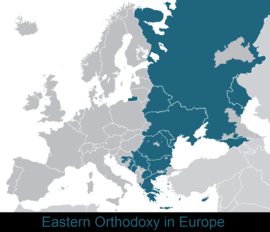Byzantine commonwealth
The term Byzantine commonwealth was coined by 20th-century historians to refer to the area where Byzantine general influence (Byzantine liturgical and cultural tradition) was spread during the Middle Ages by the Byzantine Empire and its missionaries. This area covers approximately the modern-day countries of Greece, Cyprus, North Macedonia, Bulgaria, Serbia, Montenegro, Romania, Moldova, Ukraine, Belarus, southwestern Russia, and Georgia (known as the region of Eastern Orthodoxy in Europe).
The Obolensky model
The most important treatment of the concept is a study by Dimitri Obolensky, The Byzantine Commonwealth.[1] In his book Six Byzantine Portraits he examined the life and works of six persons mentioned in The Byzantine Commonwealth.[2] He also described the commonwealth as the international community within the sphere of authority of the Byzantine emperor, bound by the same profession of Eastern Christianity, and accepting the principles of Romano-Byzantine law.[3]
There are scholars, however, who criticize this conceptualization, disputing the notion of an unchallenged superiority of the Byzantine empire. It is argued that the complex and multi-faceted dynamics of documented cultural exchange was not aligned with the theory that Constantinople was the superior core while those in periphery understood their marginal position and merely imitated their superiors.[4] Instead of Byzantine Commonwealth, historian Christian Raffensperger, proposed that it be recast as the "Byzantine ideal". Bulgaria was constant and powerful rival during the Middle Ages. Here, the empire maintains its belief in the traditional hierarchy and the imperial authority while its reach and sway were already considerably diminished.[5]
See also
References
- Obolensky, Dimitri, The Byzantine Commonwealth: Eastern Europe, 500-1453. (1971)
- Obolensky, Dimitri, Six Byzantine Portraits. (1988)
- Speake, Graham (2018). A History of the Athonite Commonwealth: The Spiritual and Cultural Diaspora of Mount Athos. Cambridge, UK: Cambridge University Press. pp. 5–6. ISBN 9781108425865.
- Boeck, Elena (2015). Imagining the Byzantine Past: The Perception of History in the Illustrated Manuscripts of Skylitzes and Manasses. Cambridge, UK: Cambridge University Press. p. 11. ISBN 9781107085817.
- Hilsdale, Cecily (2014). Byzantine Art and Diplomacy in an Age of Decline. Cambridge, UK: Cambridge University Press. p. 329. ISBN 9781107033306.
Sources
- Obolensky, Dimitri (1974) [1971]. The Byzantine Commonwealth: Eastern Europe, 500-1453. London: Cardinal.CS1 maint: ref=harv (link)
Further reading
- Billinis, Alexander. The Eagle Has Two Faces: Journeys Through Byzantine Europe. AuthorHouse Publishing, 2011. ISBN 9781456778705.
- Miliana Kaimakamova; Maciej Salamon (2007). Byzantium, new peoples, new powers: the Byzantino-Slav contact zone, from the ninth to the fifteenth century. Towarzystwo Wydawnicze "Historia Iagellonica". ISBN 978-83-88737-83-1.
- Meyendorff, John (1983), The Byzantine Legacy in the Orthodox Church. St Vladimir's Seminary Press, ISBN 0-913836-90-7.
